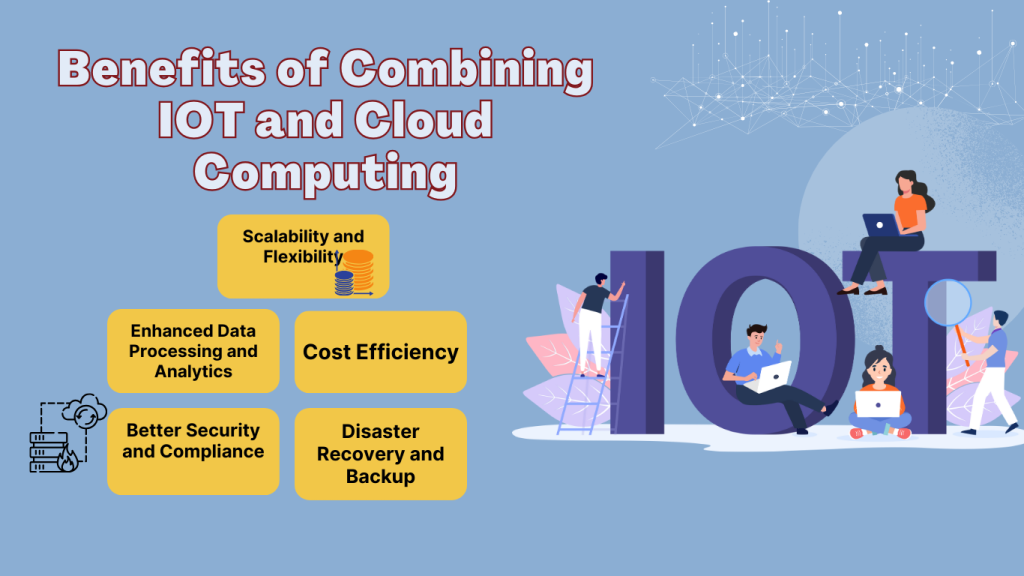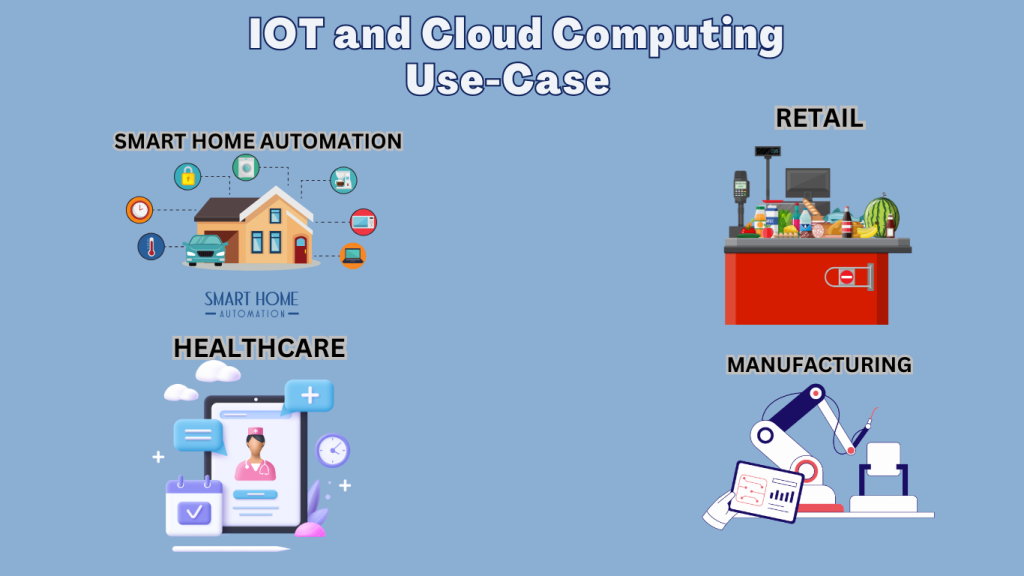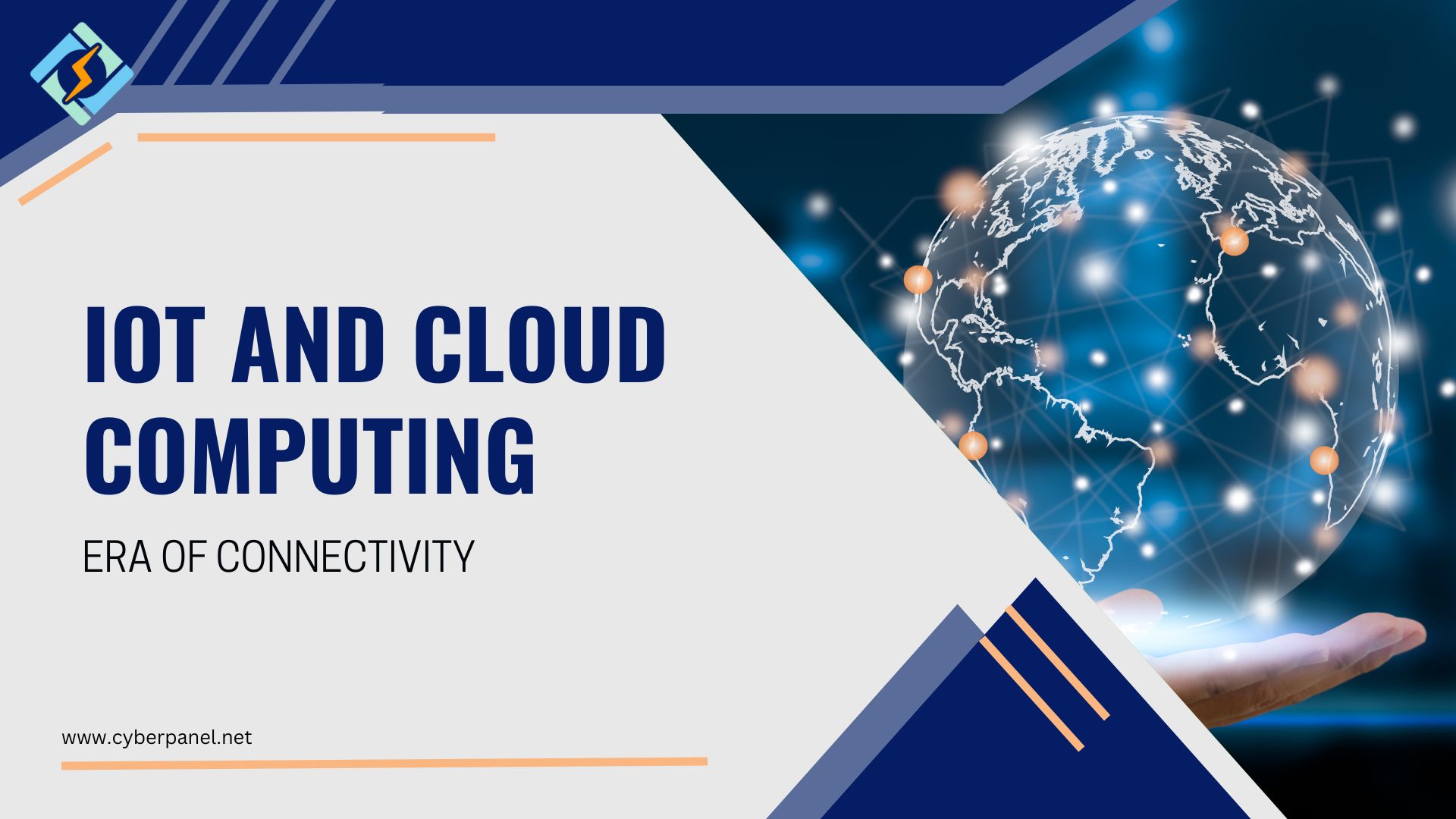The integration of IoT and cloud computing enables remote device management, process gathering, scalable operations, and data analysis from IoT devices.
This dynamic combination is very powerful and enables companies to leverage massive volumes of data from networked devices, resulting in increased productivity, reduced expenses, and creative applications of artificial intelligence and machine learning.
The scalability of cloud IoT platforms enables large-scale data processing, analytics, and artificial intelligence (AI). Millions of sensors are used by today’s infrastructure, including rail, marine, and aviation transportation systems as well as power grids and telecommunications networks.
This article delves deeply into each, explores IoT Cloud Integration including the advantages, and difficulties faced, explores real-world applications across industries utilizing this technology, and future predictions for how 5G, AI, machine learning, and other areas will enhance this even further.
Brief Overview of IoT and Cloud Computing
What is IoT (Internet of Things) and How Does it Work With Cloud Computing?
An Internet of Things is a network of connected devices that share data and communicate with cloud computing serving as the foundation for effective data processing and analysis.
The devices in question range from high-tech industrial gear to everyday household equipment like smart thermostats and wearables.
Get exclusive access to all things tech-savvy, and be the first to receive
the latest updates directly in your inbox.
Key Attributes of IoT:
- Connectivity: Data interchange is made possible via devices’ internet connections.
- Data collection: Sensors in Internet of Things devices collect real-time environmental data.
- Automation: Data-driven automated responses, such as turning on lights when someone enters a room, are made possible by the Internet of Things (IoT).
- Remote Control and Monitoring: Users can control and monitor devices remotely using computers or cell phones.
- Scalability: Internet of Things networks can link millions of devices, opening up a plethora of applications.
What is Cloud Computing?
Cloud computing provides the necessary infrastructure with the tools and services needed to create IoT applications. The cloud supports services, such as analytics, reporting, device connection, scalable storage, identity and access management (IAM) in the Internet of Things, and more. IoT devices benefit from scalability, real-time data processing, and secure remote management by utilizing the cloud.
Cloud is comprised of virtual data centers that also provide hardware, software, and resources as needed. The three service models in cloud computing are IaaS, PaaS, and SaaS. It allows companies and people to manage and access these services on a pay-per-use basis without having to make a hardware investment.
Key Attributes of Cloud Computing:
- Scalability: IoT networks may scale effectively and serve millions of linked devices thanks to cloud computing. Cloud-based IoT platforms may evolve to accommodate more data traffic as demand increases.
- Flexibility: Enables users to operate from any location with an internet connection by giving them flexible access to computer resources.
- Cost-Efficiency: cloud computing platforms remove the need for expensive on-site equipment and let companies pay only for the resources they use, increasing the affordability of IoT solutions.
- Robust security: features offered, including disaster recovery and data encryption that protect the IoT and Cloud Computing data.
- Resource Sharing: Resources are pooled and shared among multiple users to maximize consumption.
How IoT and Cloud Computing Work Together to Transform Industries?
The Internet of Things (IoT) and Cloud computing are the two cutting-edge technologies of today’s digital world. By leveraging the cloud’s powerful capabilities, businesses have linked devices and collected data on a scale that was previously impossible unlocking new capabilities and efficiencies.
Organizations can now make sense of all that data thanks to IoT and cloud computing, which has given us new ways to interact with our surroundings. These technologies combined are changing the way we live and work.
Together, cloud computing and the Internet of Things are revolutionizing the way people engage with technology and data. Large volumes of data are gathered by IoT devices from the real world, and cloud computing offers the infrastructure required to store, process, and analyze this data. When combined, they make possible a level of automation and understanding that was previously impossible — powered by advanced cloud automation platform solutions that streamline infrastructure management and scalability.
IoT and Cloud computing work together and are used to store IoT data. The cloud is a centralized server that has constantly available computing resources. Massive data packages are produced by the Internet of Things and are simply transferred by cloud computing.
The cloud provides the scalability needed to handle the growing number of IoT devices and apps, making it simple for businesses to adapt to changing client demands.
Top 5 Benefits of Combining IoT and Cloud Computing
Businesses are operating differently because of IoT and cloud computing, which have significantly boosted productivity and efficiency. Together, these technologies improve data administration, analysis, and collection.
Despite their differences, the two paradigms are complementary rather than contradictory technologies.
Let’s look at the following key advantages that organizations get by incorporating IoT and cloud computing.


Cost Effectiveness
One of the main benefits of integrating IoT and Cloud Computing is Cost savings. Businesses can save money by using the cloud for data processing and storage instead of the expensive on-premises infrastructure.
Businesses can save money on maintenance by using cloud infrastructure for data processing and storage instead of expensive on-premises tools.
IoT devices can also help reduce costs by enabling easier data access and more efficient data collection.
Because of its elasticity, the cloud may be scaled up or down to match changing workloads and save even more money.
- Decreased Infrastructure Costs: By doing away with the requirement for physical data centers, cloud computing lowers capital costs.
- Versatile Pricing Structures: Pay-as-you-go cloud pricing allows companies to only pay for the resources they use.
- Effective Data Gathering: IoT devices improve data accessibility, which lowers the cost of data administration.
As more businesses utilize these technologies, their effectiveness and affordability are likely to increase even further.
Scalability and Flexibility
IoT and Cloud computing provide the infrastructure required to manage the enormous amount of data produced by IoT devices. This allows businesses to expand without having to invest in new hardware.
Cloud computing allows for dynamic resource allocation, allowing businesses to adjust their processing and storage capacity in response to shifting demand.
This kind of adaptability is essential for managing the diverse volumes of data generated by IoT devices.
Security
IoT and cloud computing security are major concerns. Thankfully, cloud providers have strong security protocols in place to safeguard private information gathered by IoT devices.
To protect data, cloud systems offer authentication, access limits, and encryption.
Many cloud providers guarantee ethical data management methods by adhering to industry standards and legislation.
Disaster Recovery and Backup
Valuable IoT and Cloud computing data are safeguarded from getting lost or damaged thanks to the strong disaster recovery and backup options provided by cloud computing.
The cloud enables data redundancy, the technique of keeping copies of data across multiple locations to improve availability and reliability. Cloud-based recovery solutions provide quick information restoration in the event of data loss.
Enhanced Data Processing and Analytics
The data from IoT devices can be processed instantly by Cloud platforms, which allows for quick decision-making and immediate insights. This is very beneficial for applications like smart city management and predictive maintenance.
Additionally, robust analytics tools provided by these platforms are capable of handling big data, enabling companies to find patterns that drive efficiency and innovation and derive valuable insights.
Real-world Applications of IoT and Cloud Computing

The integration of IoT and Cloud computing has led to many significant changes across several industries, allowing businesses to enhance customer experiences, expedite procedures, and acquire more insight and efficiency.
Siemens’ smart building initiatives, Ecolab’s Industrial Internet of Things (IoT) platform, and other well-known examples of IoT and cloud computing implementations for real-world use cases and the elevator solutions from Otis, smart cities, healthcare, Manufacturing, Retail, Transformation, and home automation. Here are some notable examples:
Smart Cities
- IoT in Traffic Management Real-time data collection from IoT sensors in traffic lights and roadways.
- Using cloud processing can shorten travel times and enhance traffic flow.
- Linking smart security cameras and lighting that support the Internet of Things to provide real-time analytics and crisis management.
- Minimizing expenses and the impact on the environment by streamlining trash management routes and timetables.
Healthcare
- IoT-enabled medical devices like wearables and smart medical equipment collect patient health data, which is analyzed in the cloud to monitor conditions, alert caregivers, and improve treatment plans.
- Using Internet of Things devices, cloud computing for telehealth allows for real-time video consultations.
- Makes remote consultations and tests possible.
- Enables efficient inventory control in medical facilities by enabling asset monitoring.
Manufacturing
- Collects data on performance and wear for predictive maintenance like equipment failures and schedule maintenance, minimizing downtime.
- Improves quality control by keeping an eye on manufacturing procedures and looking for flaws.
- increases supply chain efficiency by monitoring the flow of raw materials and managing inventory levels.
Otis ONE Digital Service
- One of the largest elevator and escalator manufacturing, installation, and service companies in the world, it integrates IoT and cloud capabilities.
- lets cloud-based remote elevator monitoring for customers.
- Offers data insights in real time.
- Incorporates performance, health, and diagnostic data in addition to machine analytics.
Home Automation
- Gathers performance and wear data to anticipate equipment problems and plan maintenance, reducing downtime.
- Enhances quality control by checking for defects and analyzing manufacturing processes.
- Increases stock levels and monitors raw material flow to maximize supply chain efficiency.
Challenges in Integrating IoT and Cloud Computing
Let’s look at some of the problems faced when organizations combine IoT and Cloud challenges.
Security and Data Breaches
The main concerns with cloud computing are thought to be security issues and data breaches. If there is a problem with the cloud computing provider’s network, hackers might be able to access not only your data but also the data of all other subscribers.
Internet Access
To access the cloud, you must have internet connectivity. In the case of an internet outage, you will not be able to access your data.
Migration
Transferring large volumes of data can be time-consuming and vulnerable to human errors, whether you’re transitioning to cloud computing or switching between cloud providers.
However, by using automation technologies like task automation or RPA bots, businesses may optimize data migration operations and reduce errors and human interference.
Costs
An IoT cloud storage base can be expensive initially, particularly if the business needs a private domain.
For instance, a company needing 5 TB or more of capacity would pay $2,250 per month under Google Cloud’s price plan.
Environmental Concerns
Although cloud computing lowers carbon emissions, it has drawbacks including increased sea temperatures, flooding concerns, and cooling expenses. Forty percent of the energy used is used by cloud providers to chill their facilities.
Furthermore, undersea fiber cables, which transport 95% of all communications worldwide, are increasingly susceptible to disruption as a result of rising sea levels and temperatures.
Future Trends in IoT and Cloud Computing
The future of the Internet of Things IoT and Cloud computing is difficult to predict but the need for these services is growing swiftly as more and more companies come to understand the potential of emerging IoT technology.
However, a few broad trends show the general direction these industries are heading.
Here’s a thorough look at what the Internet of Things IoT and cloud computing may bring in the future.
Major Impact on:
- AI and ML
- Data Security
- IoT Security and Privacy Enhancements
- Healthcare
- Edge Computing
AI and Machine Learning
Cloud computing is being revolutionized by AI and Machine Learning (ML), which provide superior processing power and scalability at a reasonable price. Prominent cloud service providers, like Google, IBM, and Amazon, are making significant investments in AI/ML technologies, which are predicted to transform industries like:
- downtime-reducing predictive maintenance for cloud infrastructure.
- scaling that is automated to effectively distribute resources in response to demand.
- detection of security threats by looking for anomalies in cloud settings.
- IoT device insights in real-time with advanced data analytics.
Cloud Providers will further invest in AI and ML technologies, look at some of the following examples of computing’s Integration of AI and ML:
- Predictive cloud infrastructure maintenance.
- Scaling and supply of resources automatically.
- Finding and identifying irregularities and security risks.
- Natural language processing for chatbots and virtual assistants.
- Content optimization and tailored suggestions.
- Pattern identification and intelligent data analytics.
Cloud Computing Security Enhancement
Data security is still of the highest priority as cloud adoption increases. For businesses to avoid data loss, theft, and unauthorized access, secure environments are essential. In response, cloud providers are providing automated data recovery solutions, multi-factor authentication, and advanced encryption mechanisms.
The handling of enormous volumes of sensitive data via cloud computing and IoT makes these advancements imperative.
IoT Security and Privacy Concerns
It is expected that there will be 29.4 billion IoT devices by 2030, up from 15.1 billion in 2023.
IoT devices are employed across industries like smart cities, healthcare, and automotive, all with varied security demands. To defend against cyberattacks, cloud providers are strengthening IoT-specific security procedures, such as enhanced authentication techniques and encrypted data flows.
Healthcare
The healthcare industry is another one where IoT in cloud computing is probably going to have a big impact. Fitbits and Apple Watches are two examples of connected devices that people are already utilizing to track their fitness levels and manage their health.
Furthermore, IoT-enabled medical gadgets will allow people to undergo therapy from home instead of having to travel to a hospital or clinic.
Edge Computing: Revolutionalizing IoT and Cloud Computing
By processing data closer to its source, edge computing helps businesses handle information more quickly and more efficiently. As companies implement IoT devices in industries like manufacturing and smart cities, this tendency is quickening. Businesses can react to real-time events faster and obtain useful insights by processing data at the edge, which ultimately spurs efficiency and creativity.
This is one of the cloud computing trends that will accelerate the use of edge across sectors, hence driving IoT development and applications.
In conclusion, IoT and cloud computing are about to be redefined by the integration of AI, improved data security protocols, and edge computing. This will allow organizations to develop more quickly while maintaining security and privacy.
Final Thoughts on IoT and Cloud Computing Relation
In this post, we looked at the transformative benefits of integrating IoT and cloud computing, the challenges faced, and the upcoming trends that we should expect to see rise in popularity.
When businesses invest in and adapt to cloud computing, a critical component of the Internet of Things, they can fully utilize the analytics, security, and data management it offers, allowing them to realize the full potential of IoT data technology.
FAQ’S
What is the relationship between IoT and Cloud Computing?
IoT and cloud computing go hand in hand. Data is transferred from IoT devices to the cloud, where it is stored, processed, and analyzed to provide real-time insights and decision-making.
Why is security a major concern for IoT and Cloud Computing?
IoT devices gather sensitive data and require strong security to prevent cyberattacks. Data security must be maintained by cloud platforms during processing and storage.
What are some real-world applications of IoT and Cloud Computing?
In the real world, IoT devices are used in smart homes to manage lighting and security; in healthcare to provide remote monitoring and telemedicine; and in manufacturing to increase productivity and safety through the use of IoT sensors.
IoT and cloud computing enhance customer experiences and retail inventory management through data-driven insights.
What are the latest trends in IoT and Cloud Computing?
Emerging IoT and Cloud computing trends include the development of edge computing for quicker data processing, 5G connectivity for better device communication, stronger data security measures, AI integration for more intelligent IoT solutions, and an emphasis on sustainability to lessen environmental effects are some of the major themes.



